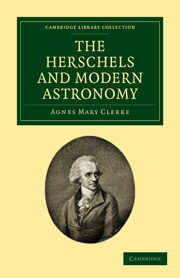Book contents
- Frontmatter
- PREFACE
- Contents
- ILLUSTRATIONS
- CHAPTER I EARLY LIFE OF WILLIAM HERSCHEL
- CHAPTER II THE KING'S ASTRONOMER
- CHAPTER III THE EXPLORER OF THE HEAVENS
- CHAPTER IV HERSCHEL'S SPECIAL INVESTIGATIONS
- CHAPTER V THE INFLUENCE OF HERSCHEL'S CAREER ON MODERN ASTRONOMY
- CHAPTER VI CAROLINE HERSCHEL
- CHAPTER VII SIR JOHN HERSCHEL AT CAMBRIDGE AND SLOUGH
- CHAPTER VIII EXPEDITION TO THE CAPE
- CHAPTER IX LIFE AT COLLINGWOOD
- CHAPTER X WRITINGS AND EXPERIMENTAL INVESTIGATIONS
- INDEX
- Plate section
CHAPTER V - THE INFLUENCE OF HERSCHEL'S CAREER ON MODERN ASTRONOMY
Published online by Cambridge University Press: 05 October 2010
- Frontmatter
- PREFACE
- Contents
- ILLUSTRATIONS
- CHAPTER I EARLY LIFE OF WILLIAM HERSCHEL
- CHAPTER II THE KING'S ASTRONOMER
- CHAPTER III THE EXPLORER OF THE HEAVENS
- CHAPTER IV HERSCHEL'S SPECIAL INVESTIGATIONS
- CHAPTER V THE INFLUENCE OF HERSCHEL'S CAREER ON MODERN ASTRONOMY
- CHAPTER VI CAROLINE HERSCHEL
- CHAPTER VII SIR JOHN HERSCHEL AT CAMBRIDGE AND SLOUGH
- CHAPTER VIII EXPEDITION TO THE CAPE
- CHAPTER IX LIFE AT COLLINGWOOD
- CHAPTER X WRITINGS AND EXPERIMENTAL INVESTIGATIONS
- INDEX
- Plate section
Summary
The powers of the telescope were so unexpectedly increased, that they may almost be said to have been discovered by William Herschel. No one before him had considered the advantages of large apertures. No one had seemed to remember that the primary function of an instrument designed to aid vision is to collect light. The elementary principle of space-penetration had not been adverted to. It devolved upon him to point out that the distances of similar objects are exactly proportional to the size of the telescopes barely sufficing to show them. The reason is obvious. Compare, for instance, a one-inch telescope with the naked eye. The telescope brings to a focus twenty-five times as much light as can enter the pupil, taken at one-fifth of an inch in diameter; therefore it will render visible a star twenty-five times fainter than the smallest seen without its help; or—what comes to the same thing—an intrinsically equal star at a five-fold distance. A one-inch glass hence actually quintuples the diameter of the visible universe, and gives access to seventy-five times the volume of space ranged through by the unassisted eye.
This simple law Herschel made the foundation-stone of his sidereal edifice. He was the first to notice it, because he was the first practically to concern himself with the star-depths.
- Type
- Chapter
- Information
- The Herschels and Modern Astronomy , pp. 98 - 114Publisher: Cambridge University PressPrint publication year: 2010First published in: 1895



